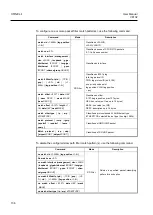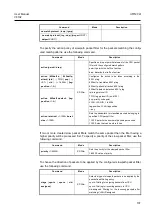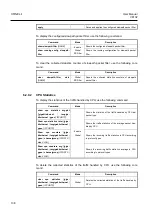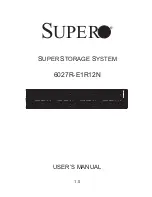
UMN:CLI
User Manual
V8102
150
7.1.10.2
SNMP Trap Host
To set an SNMP trap host, use the following command.
Command
Mode
Description
snmp trap-host
A.B.C.D
[
COM-
MUNITY
]
Global
Specifies an SNMP trap v1 host.
snmp trap2-host
A.B.C.D
[
COM-
MUNITY
]
Specifies an SNMP trap v2 host.
snmp inform-trap-host
A.B.C.D
[
COMMUNITY
]
Specifies an SNMP inform trap host.
To delete a specified SNMP trap host, use the following command.
Command
Mode
Description
no snmp trap-host
A.B.C.D
Global
Deletes a specified SNMP trap v1 host.
no snmp trap2-host
A.B.C.D
Deletes a specified SNMP trap v2 host.
no snmp inform-trap-host
A.B.C.D
Deletes a specified SNMP inform trap host.
You can set maximum 16 SNMP trap hosts with inputting one by one.
The following is an example of setting an SNMP trap host.
SWITCH(config)#
snmp
trap-host
10.1.1.3
SWITCH(config)#
snmp trap-host
20.1.1.5
SWITCH(config)#
snmp trap-host
30.1.1.2
SWITCH(config)#
7.1.10.3
Enabling SNMP Trap
The system provides various kind of SNMP trap, but it may inefficiently work if all these
trap messages are sent very frequently. Therefore, you can select each SNMP trap sent
to an SNMP trap host.
•
auth-failure
is shown to inform wrong community is input when user trying to access
to SNMP inputs wrong community.
•
cold-start
is shown when SNMP agent is turned off and restarts again.
•
link-up/down
is shown when network of port specified by user is disconnected, or
when the network is connected again.
•
mem-threshold
is shown when memory usage exceeds the threshold specified by
user. When memory usage falls below the threshold, the trap message will be shown
to notify it.
•
cpu-threshold
is shown when CPU utilization exceeds the threshold specified by
user. When CPU load falls below the threshold, trap message will be shown to notify
it.
•
port-threshold
is shown when the port traffic exceeds the threshold configured by
ii














































